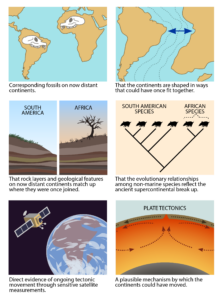Powerful scientific ideas generate many different expectations, not just one. As an example, let’s return to the idea that the continents as we know them today were once joined together into a supercontinent and have been moving apart ever since. This idea generates many different expectations; we would expect to find:
From ancient fossils to cutting-edge satellite measurements, the expectations generated by this idea have all been borne out in actual observations. Such diverse observations all pointing to a single idea (in this case, plate tectonics) provide that idea with robust support that can withstand the prodding and scrutiny of science — like a table built on many legs, instead of a couple wobbly ones.
So one hypothesis or theory is often related to many different sorts of expected observations — all of which reflect on its accuracy. It’s no wonder then that evaluating scientific ideas is not cut and dried: some expectations generated by an idea might be borne out and support it, while others might not.
For an example of how one idea can generate multiple expectations (and may depend on multiple lines of evidence), check out the story of Lynn Margulis, Cells within cells: An extraordinary claim with extraordinary evidence.
To review some of the standards used to assess scientific ideas, visit Competing ideas: A perfect fit for the evidence and Competing ideas: Other considerations.
Many activities can help students generate explanations that are constrained by evidence (e.g., Dino-data). This sort of activity could be easily adapted for different scientific disciplines. The idea is simply to present students with evidence and encourage them to come up with multiple explanations that fit with the available evidence. As new lines of evidence are revealed, they can modify their potential explanations.

